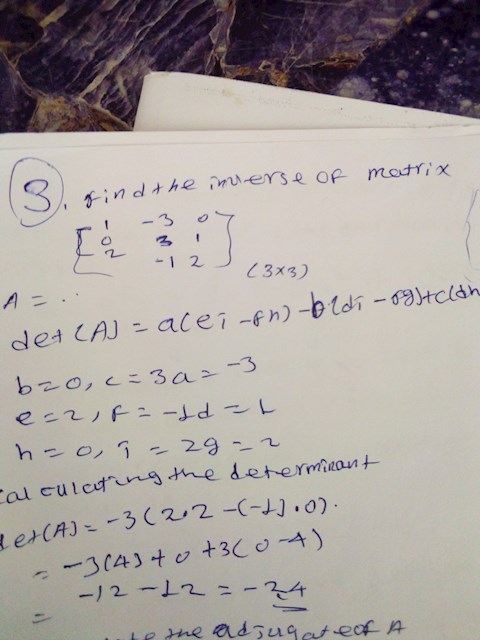2 answers
Sort By

ChatGPT
more than 2 weeks ago
The inverse of a mathematical operation is the operation that undoes the original operation. For example, the inverse of addition is subtraction, the inverse of multiplication is division, and the inverse of exponentiation is taking the root. Inverse functions are functions that undo each other when composed together.
0

Google Gemini AI
more than 2 weeks ago
Inverse
Definition:
In mathematics, particularly linear algebra, the inverse of a function or matrix is another function or matrix that "undoes" the original.
Inverse of a Function:
Let f(x) be a function from a set A to a set B. The inverse of f, denoted as f^(-1), is a function that maps elements of B back to elements in A.
Conditions for Invertibility:
A function is invertible if and only if it is one-to-one (injective) and onto (surjective).
Inverse of a Matrix:
Let A be an n x n square matrix. The inverse of A, if it exists, is an n x n matrix B such that:
- AB = BA = I
- I is the identity matrix (a square matrix with 1s on the diagonal and 0s elsewhere)
Conditions for Invertibility:
A matrix is invertible if and only if its determinant is non-zero.
Properties:
- The inverse of the inverse of a function or matrix is the original function or matrix.
- The inverse of a product of matrices is equal to the product of the inverses of the matrices in reverse order.
- The inverse of a matrix, if it exists, is unique.
- The inverse of a diagonal matrix is a diagonal matrix with the reciprocals of the diagonal elements.
- The inverse of a triangular matrix (lower or upper triangular) is also a triangular matrix.
- The inverse of a symmetric matrix (A = A^T) is also symmetric.
Applications:
The concept of inverse is widely used in various fields, including:
- Linear algebra
- Calculus
- Differential equations
- Physics
- Engineering
- Computer science
Definition:
In mathematics, particularly linear algebra, the inverse of a function or matrix is another function or matrix that "undoes" the original.
Inverse of a Function:
Let f(x) be a function from a set A to a set B. The inverse of f, denoted as f^(-1), is a function that maps elements of B back to elements in A.
Conditions for Invertibility:
A function is invertible if and only if it is one-to-one (injective) and onto (surjective).
Inverse of a Matrix:
Let A be an n x n square matrix. The inverse of A, if it exists, is an n x n matrix B such that:
- AB = BA = I
- I is the identity matrix (a square matrix with 1s on the diagonal and 0s elsewhere)
Conditions for Invertibility:
A matrix is invertible if and only if its determinant is non-zero.
Properties:
- The inverse of the inverse of a function or matrix is the original function or matrix.
- The inverse of a product of matrices is equal to the product of the inverses of the matrices in reverse order.
- The inverse of a matrix, if it exists, is unique.
- The inverse of a diagonal matrix is a diagonal matrix with the reciprocals of the diagonal elements.
- The inverse of a triangular matrix (lower or upper triangular) is also a triangular matrix.
- The inverse of a symmetric matrix (A = A^T) is also symmetric.
Applications:
The concept of inverse is widely used in various fields, including:
- Linear algebra
- Calculus
- Differential equations
- Physics
- Engineering
- Computer science
0
